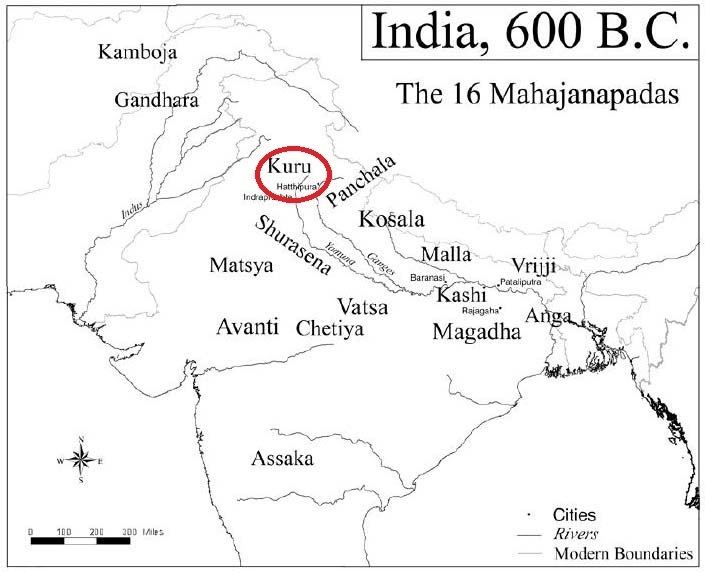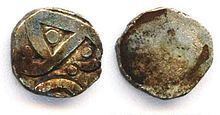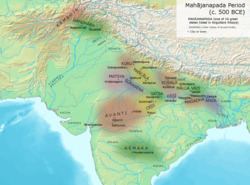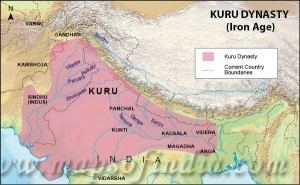Established c. 1400 BCE | ||
 | ||
Religion Vedic HinduismBrahmanism | ||
Kuru kingdom
Kuru (Sanskrit: कुरु) was the name of a Vedic Indo-Aryan tribal union in northern Iron Age India, encompassing the modern-day states of Delhi, Haryana, Uttarakhand and western part of Uttar Pradesh, which appeared in the Middle Vedic period (c. 1200 – c. 850 BCE) and developed into the first recorded state-level society in South Asia around 1000 BCE, corresponding archaeologically to the Painted Grey Ware culture. It decisively changed the Vedic heritage of the early Vedic period, arranging the Vedic hymns into collections, and developing new rituals which gained their position in Indian civilization as the orthodox srauta rituals, which contributed to the so-called "classical synthesis" or "Hindu synthesis".
Contents

It became the dominant political and cultural center of the middle Vedic Period during the reigns of Parikshit and Janamejaya, but it declined in importance during the Late Vedic period (c. 850-500 BCE), and had become "something of a backwater" by the Mahajanapada period in the 5th century BCE. However, traditions and legends about the Kurus continued into the post-Vedic period, providing the basis for the Mahabharata epic.

History

The Kurus figure prominently in the later Rigveda. The Kurus here appear as a branch of the early Indo-Aryans, ruling the Ganga-Jamuna Doab and modern Haryana. The focus in the later Vedic period shifted out of Punjab, into the Doab, and thus to the Kuru clan. The increasing number and size of Painted Grey Ware (PGW) settlements in the Doab area shows this. These developments resulted in the substantial enlargement of certain settlements such as Hastinapur and Kaushambi towards the end of the Later Vedic period. These settlements slowly began to acquire characteristics of towns.

The Kuru tribe was formed, in the Middle Vedic period, as a result of the alliance and merger between the Bharata and Puru tribes. With their center of power in the Kurukshetra region, the Kurus formed the first political center of the Vedic period, and were dominant roughly from 1200 to 800 BCE. The first Kuru capital was at Āsandīvat, identified with modern Assandh in Haryana. Later literature refers to Indraprastha (modern Delhi) and Hastinapura as the main Kuru cities.

The Atharvaveda (XX.127) praises Parikshit, the "King of the Kurus", as the great ruler of a thriving, prosperous realm. Other late Vedic texts, such as the Shatapatha Brahmana, commemorate Parikshit's son Janamejaya as a great conqueror who performed the ashvamedha (horse-sacrifice). These two Kuru kings played a decisive role in the consolidation of the Kuru state and the development of the srauta rituals, and they also appear as important figures in later legends and traditions (e.g. in the Mahabharata).
The Kurus declined after being defeated by the non-Vedic Salva tribe, and the center of Vedic culture shifted east, into the Panchala realm, in Uttar Pradesh. In the later Vedic period, the capital of the Kurus was transferred to Kaushambi, in the lower Doab, after Hastinapur was destroyed by floods as well as because of upheavals in the Kuru family itself. In the late Vedic period (by the 6th century BCE), the Kuru dynasty evolved into Kuru and Vatsa janapadas, ruling over Upper Doab/Delhi/Haryana and lower Doab, respectively. The Vatsa branch of the Kuru dynasty further divided into branches at Kaushambi and at Mathura.
Society
The tribes that consolidated into the Kuru Kingdom or 'Kuru Pradesh' were largely semi-nomadic, pastoral tribes. However, as settlement shifted into the western Ganges Plain, settled farming of rice and barley became more important. Vedic literature of this time period indicates the growth of surplus production and the emergence of specialized artisans and craftsmen. Iron was first mentioned as śyāma ayas (literally "black metal") in the Atharvaveda, a text of this era. Another important development was the fourfold varna (class) system, which replaced the twofold system of arya and dasa from the Rigvedic times. The Brahmin priesthood and Kshatriya aristocracy, who dominated the arya commoners (now called vaishyas) and the dasa labourers (now called shudras), were designated as separate classes.
Kuru kings ruled with the assistance of a rudimentary administration, including purohita (priest), village headman, army chief, food distributor, emissary, herald and spies. They extracted mandatory tribute (bali) from their population of commoners as well as from weaker neighboring tribes. They led frequent raids and conquests against their neighbors, especially to the east and south. To aid in governing, the kings and their Brahmin priests arranged Vedic hymns into collections and developed a new set of rituals (the now orthodox Srauta rituals) to uphold social order and strengthen the class hierarchy. High-ranked nobles could perform very elaborate sacrifices, and many rituals primarily exalted the status of the king over his people. The ashvamedha or horse sacrifice was a way for a powerful king to assert his domination in northern India.
In epic literature
The epic poem, the Mahabharata, tells of a conflict between two branches of the reigning Kuru clan possibly around 1000 BCE. However, archaeology has not furnished conclusive proof as to whether the specific events described have any historical basis. The existing text of the Mahabharata went through many layers of development and mostly belongs to the period between c. 400 BCE and 400 CE. Within the frame story of the Mahabharata, the historical kings Parikshit and Janamejaya are featured significantly as scions of the Kuru clan.
Kuru Family Tree
This shows the line of both parentage and succession, according to the Mahabharata. See the notes below for detail.
Key to Symbols
Notes
